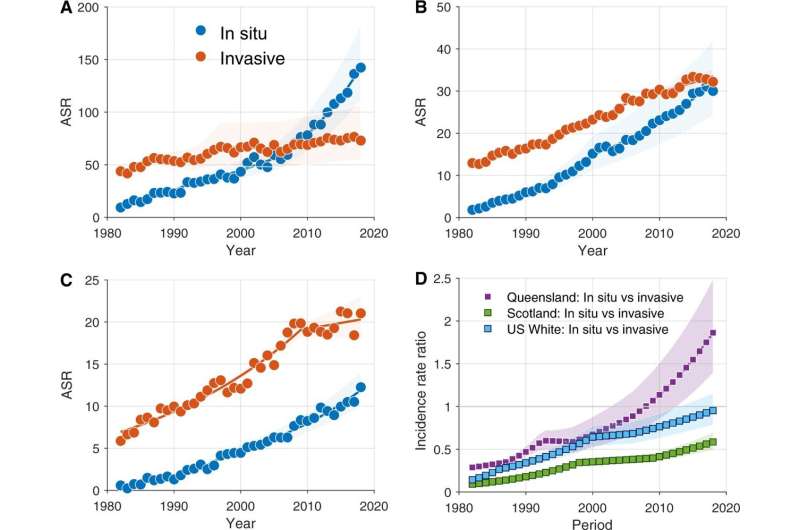
New QIMR Berghofer research has identified a dramatic increase in the treatment of “pre-cancerous” melanomas in Australia and found strong evidence that similar trends are emerging across the globe.
The study suggests that many of these pre-cancers may not actually be harmful to the patient and, therefore, may not have needed treatment.
In an attempt to understand why melanoma incidence has been rising around the world, lead researcher, Professor David Whiteman, and colleagues examined long-term skin cancer trends in Queensland, Scotland and the United States, using a new statistical method developed by co-authors at the U.S. National Cancer Institute, part of the U.S. National Institutes of Health.
“Using nearly 40 years of data, our research team compared rates of pre-invasive melanoma (also called ‘melanoma in situ’) and invasive melanoma in Queensland, Scotland, and the United States. We found that rates of pre-invasive melanomas have been rising much faster than rates of dangerous melanomas across all three populations,” Professor Whiteman said.
“In addition, we found that patients with pre-invasive melanomas were, on average, several years older than patients with invasive melanomas. This finding is opposite to what we had expected under the existing assumption that all pre-invasive melanomas later go on to become invasive. If that assumption was true, then people with pre-invasive melanomas should be younger than people with invasive melanomas, not older.
“Taken together, these findings strongly suggest that we are increasingly detecting and treating many lesions that ultimately would have caused no harm if they were left undiagnosed.
“It’s a particularly pronounced trend in Queensland, where residents have long been aware of their high skin cancer risk, but our study shows it’s also a rapidly emerging issue in the United States and Scotland.”
The new study was published in the Journal of the National Cancer Institute on Wednesday, August 31. It builds on previous QIMR Berghofer research, which found nearly a third of melanomas picked up during routine Queensland skin checks may not be harmful.
Professor Whiteman has stressed that the research does not diminish the ongoing importance of skin cancer prevention, screening, and treatment, as melanoma is still a very dangerous cancer that claims thousands of lives each year.
Rather, the study highlights the need for even better diagnostic tools that more precisely distinguish those truly aggressive melanomas with lethal potential from other pigmented skin lesions that are benign.
“Unnecessary melanoma diagnoses and surgeries can cause a lot of pain and anxiety for patients, and also incur considerable expense to both individuals and healthcare systems,” Professor Whiteman said.
“The holy grail of melanoma research is to develop a diagnostic tool that can reliably and accurately diagnose pre-invasive melanomas as harmful or benign, in the hope that we can spare some patients unnecessary surgery—and the suffering and expense that comes with it.
“Our data demonstrates a huge market for such a tool, as millions of excisions occur each year and the global burden of skin cancer continues to grow.”
Source: Read Full Article
